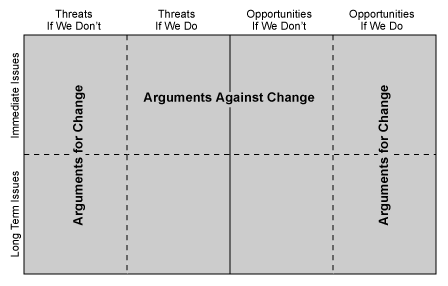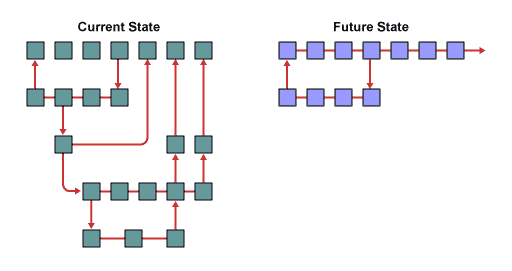
One phrase in Lean Six Sigma that may be heard more than any other is “culture change.” Most organizations today are undergoing some form of culture change, and 75 percent of all major or cultural changes fail to achieve their goals. Experience shows when strength and culture collide, culture has a higher probability of winning.
Change takes time and commitment. While some resistance to change is inevitable, there are ways to accelerate change through best practices using tactical tools to gain acceptance, change old habits and greatly increase the bottom line.
A Plan for Change
“For new technology to be embraced, people have to believe that it has 10 times the advantages of what people were previously doing,” according to Peter Drucker. Drucker, considered a management guru, has written numerous books on management issues and practices, including Megatrends. What are the implications of his statement?
- Management must really sell its ideas/solutions.
- People must see the benefit of the solution and that benefit must far outweigh the status quo.
- People get ingrained into a way of doing things that is hard to break.
Lean Six Sigma tools provide a technical solution, but what provides organizational acceptance? Successful changes require dual strategies.
The ‘Change Equation’
“Stakeholder” is a word frequently used in continuous improvement programs. However, Lean Six Sigma project teams must keep in mind there are two groups of stakeholders – those who are impacted by the change and those – typically leaders – who can speed or impede progress. Influencing stakeholders can be understood through the change equation:
DxVxP > R
This model implies that to overcome inevitable resistance to most change (R), there must be some level of dissatisfaction with the status quo (D), a clear behavior-based vision of where to go (V) – or the desired state, and a clear path (process or plan) to get there (P). Practically stated, teams will need to answer these questions:
- Why change?
- What will change?
- How will it change?
Need for Change and Dissatisfaction with Status Quo
A comprehensive change acceleration plan includes articulating the need for a particular change. Within DMAIC, project teams identify reasons for the target process in the Define stage – essentially building a business case for the project. As more feedback and process data become available in the Measure and Analyze phases, teams can re-address the dissatisfied component of the change equation, ultimately refining these arguments when solutions become clear (Improve). For example, a stakeholder might support working on a clearly broken process (Define, Measure, Analyze) but may not support the specific proposed change (Improve).
Teams must provide evidence the status quo is not good enough through addressing whether the current process or service is truly broken and articulating the benefits of change. An effective tool to use is a threats and opportunities matrix (Figure 1). Similar to a force field analysis, this version has four columns.

The threats and opportunities matrix helps develop a compelling argument by identifying ramifications of not making the change – or all of the bad things that would happen without changing. It also identifies benefits and opportunities of making the change. Many times the opportunities will be the antithesis of the threats; however, teams should go beyond the obvious. Sometimes viewing the issue from a different perspective can lead to additional reasons for making the change.
As a team makes a case for change, it should pay close attention to the matrix headings. If threats for making the change are identified, essentially a case is being made for not changing. With that in mind, a team should be as specific as possible. The more reasons for change the better, as different arguments will compel different stakeholders. The right argument will eventually match with the right stakeholder.
Identifying arguments against change will help the team understand potential pockets of resistance. The key is to externally communicate arguments for making the change and utilize their assessment of arguments against the change to develop rebuttals or enhance the solution.
People Are Influenced in Different Ways
Most studies indicate that influence approaches can be categorized into three strategies – data, sensory or incentive/de-incentive. Stakeholders influenced by data will probably respond well to a detailed, positive cost/benefit analysis. Sensory stakeholders may benefit from a simulation of the new process or a benchmarking visit to an organization that successfully implemented a similar change. Finally, stakeholders most influenced by incentives will most likely respond to an incentive plan rewarding behavioral changes, or the resulting de-incentive for lack of change or support. Leveraging multiple approaches in influencing stakeholders will have a higher probability of success.
Using the completed threats and opportunities matrix, a team can identify possible strategies to influence resistant stakeholders. For each threat or opportunity, identify one data element and one sensory element that would validate the threat or opportunity. Then, identify an incentive/de-incentive approach that might push stakeholders to make the change.
Creating a Behavior-Based Vision
Teams start shaping the vision for the desired state in the early stages DMAIC, but they will not be able to make that vision behavior-based until solutions are clearly defined in the Improve phase. An effective vision statement will inform stakeholders about what will actually be different in the desired state, and what they will be doing in the new environment. Using a mission/results/actions (MRA) aatrix such as the table below will help craft that vision.
| Mission/Results/Actions (MRA) Matrix | ||
|
Mission |
Results |
Actions (Behaviors) |
A solid vision should include a higher level, strategic mission or objective for the change/solution. This statement should be concise and agreed on by the team.
The vision should not stop there, however. Teams should identify and communicate organizational and individual performance expectations or results. These should be specific, measurable descriptions of what is to come, and should include both organizational goals (e.g., cycle time will be reduced by 50 percent) and individual goals.
Finally, teams should give the stakeholder a line of sight to the desired state by articulating what each stakeholder will be doing differently – their actions or behaviors – in the new environment.
Once the objective or mission of the change is agreed upon, teams should use a T-diagram to compare results and behaviors for both the current and future environments.

Creating the vision is important, communicating it is more important. Teams should take advantage of a variety of communication vehicles to “paint their picture” of the desired state. Sensory approaches are most effective. These communications tools include process mapping, simulations, models and training.
Communicating the Path to the Desired State
How does anyone move from the current state to the desired state? The path component of the change equation comes into play as solutions take form during the Improve phase. Some stakeholders will be concerned about the ability to get to the desired state or potential roadblocks and disruptions along the way. Incorporating a clear path into the communication plan is essential.
There are a number of familiar project planning, management and communication tools, such as Gantt charts, work breakdown structures, and multi-generational planning, as well as clearly documented roles and responsibilities. These same tools should be leveraged to communicate the change plan to key stakeholders. That leveraging can take the form of asking questions – an excellent way to easily communicate the plan to make the desired state a reality.
Taking Pulses of Levels of Support and Resistance
People resist change for a variety of reasons, including technical, political and cultural reasons.
- Technical: They do not know how to do the new stuff; they would have to invest time, money, effort or equipment to make the desired change; they feel they cannot do it; they truly feel the new solution is not as good as the status quo.
- Political: Real or perceived fear of losing autonomy, authority, respect, power, etc.
- Cultural: The change just does not feel right; stakeholders are used to or comfortable with the status quo; peer pressure, fear of standing out.
Like an iceberg, where only a small portion can been seen above water, most of the resistance that teams actually see is just the tip of the problem. Usually a great amount of resistance remains an undercurrent. Specifically, stakeholders tend to surface their technical reasons for resisting change – “it’ll cost too much” or “we’ll have to spend a lot of time in training.” What they often do not surface are their political and cultural reasons for resisting. Teams can use good, old fashioned interviews and feedback mechanisms to uncover technical reasons for resistance. They will need to use observation and other insights to identify political and cultural reasons for resistance.
Here are a few techniques to assess the level of support (or resistance) for their specific change effort and to identify possible reasons for that support or resistance.
Consider the following important questions:
- Who are the key stakeholders?
- What is their current level of support for this change?
- What level of support is needed from them to ensure success?
- Why are they supportive or resistant?
- What is the source of their resistance?
The most appropriate tool for this is the stakeholder analysis. This tool takes many forms; however, they all should accomplish the same goal use guidelines similar to the following:
- Identify key stakeholders
- Determine their current level of support for the project (on a 1-5 scale)
- Determine the level of support needed for the project to be successful (on a 1-5 scale)
- Identify reasons for resistance or any concerns
A typical 1-5 scale would show 1 as strongly resistant, 3 as neutral and 5 as strongly supportive. It is important to gain agreement on what each of these levels means, and keep the assessment behavioral-based. This scale can easily be adapted for more advanced analysis. For example, prioritizing stakeholders in terms of their potential impact on the success of the change effort is often helpful.
Bringing It Together in an Influential Plan
To accelerate change, teams need to focus both on coming up with a solid solution and a plan to gain acceptance. Teams need to answer the why, what and how questions for key stakeholders. In addition, teams need to assess levels of support and/resistance to their proposed change in order to effectively match influence strategies with specific stakeholders.
The goal in developing an acceptance strategy for a proposed change is to turn resistance into support. Teams must develop a detailed communication plan. It comes down to assessing the levels of support or resistance to change, answering critical stakeholder questions and building a solid acceptance strategy.